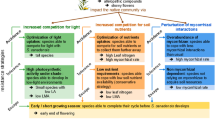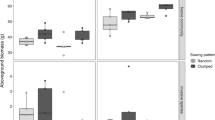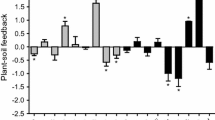Abstract
Resource competition theory suggests that the nature of diversity–resource–invasibility interactions will vary along fertility gradients, concurrent with changes in the relative availability of limiting above- versus below-ground resources. Experimental support for this contingency is lacking. Here, we manipulated resident diversity, baseline fertility, and the availabilities of light and soil nitrogen in grassland communities invaded by two functionally distinct non-native plant species (Lolium arundinaceum and Melilotus alba). We tested the hypotheses that increased resident diversity reduces community invasibility and dampens the effects of light and soil nitrogen pulses, and that the relative effects of light versus soil nitrogen additions on diversity–invasibility relationships depend on the baseline fertility of the study system. Our results reveal an overall weak negative effect of resident diversity on Lolium performance, but in contrast to our expectations, this diversity effect did not vary with light or soil nitrogen additions or with baseline fertility. However, the relative effects of above- versus below-ground resource additions on invader performance varied with baseline fertility as expected: Lolium responded most strongly to soil nitrogen additions in low-fertility mesocosms and most strongly to increased light availability in high-fertility mesocosms. In contrast to Lolium, nitrogen-fixing Melilotus was overall less responsive to diversity and resource manipulations. Together, these patterns do not lend support for the dependence of diversity–resource–invasibility relationships on either baseline fertility or invasive species identity, but they do highlight the dominant role of resources over diversity in determining invader performance, as well as the manner in which fertility alters the relative importance of above- versus below-ground resource pulses in promoting invasions.






Similar content being viewed by others
References
Allison GW (1999) The implications of experimental design for biodiversity manipulations. Am Nat 153:26–45
Bobbink R, Hicks K, Galloway J, Spranger T, Alkemade R, Ashmore M, Bustamante M, Cinderby S, Davidson E, Dentener F, Emmett B, Erisman J-W, Fenn M, Gilliam F, Nordin A, Pardo L, DeVries W (2010) Global assessment of nitrogen deposition effects on terrestrial plant diversity: a synthesis. Ecol Appl 20:30–59
Catford JA, Jansson R, Nilsson C (2009) Reducing redundancy in invasion ecology by integrating hypotheses into a single theoretical framework. Divers Distrib 15:22–40
Chase JM, Leibold MA (2003) Ecological niches—linking classical and contemporary approaches. The University of Chicago Press, Chicago
Clark CM, Tilman D (2008) Loss of plant species after chronic low-level nitrogen deposition to prairie grasslands. Nature 451:712–715
Clay K, Holah J (1999) Fungal endophyte symbiosis and plant diversity in successional fields. Science 285:1742–1744
Crews TE (1999) The presence of nitrogen fixing legumes in terrestrial communities: evolutionary vs ecological considerations. Biogeochemistry 46:233–246
Davis MA, Pelsor M (2001) Experimental support for a resource-based mechanistic model of invasibility. Ecol Lett 4:421–428
Davis MA, Grime JP, Thompson K (2000) Fluctuating resources in plant communities: a general theory of invasibility. J Ecol 88:528–534
Diboll N (1997) Designing seed mixes. In: Packard S, Mutel CF (eds) The tallgrass restoration handbook. Island Press, Washington, pp 135–149
Driscoll CT, Whitall D, Aber J, Boyer E, Castro M, Cronan C, Goodale CL, Groffman P, Hopkinson C, Lambert K, Lawrence G, Ollinger S (2003) Nitrogen pollution in the northeastern United States: sources, effects, and management options. Bioscience 53:357–374
Fargione JE, Brown CS, Tilman D (2003) Community assembly and invasion: an experimental test of neutral versus niche processes. Proc Natl Acad Sci 100:8916–8920
Foster BL, Smith VH, Dickson TL, Hildebrand T (2002) Invasibility and compositional stability in a grassland community: relationships to diversity and extrinsic factors. Oikos 99:300–307
Galloway JN, Townsend AR, Erisman JW, Bekunda M, Cai Z, Freney JR, Martinelli LA, Seitzinger SP, Sutton MA (2008) Transformation of the nitrogen cycle: recent trends, questions, and potential solutions. Science 320:880–892
Gough L, Osenberg CW, Gross KL, Collins SL (2000) Fertilization effects on species density and primary productivity in herbaceous plant communities. Oikos 89:428–439
Gurevitch J, Fox GA, Wardle GM, Inderjit, Taub D (2011) Emergent insights from the synthesis of conceptual frameworks for biological invasions. Ecol Lett 14:407–418
Hautier Y, Niklaus PA, Hector A (2009) Competition for light causes plant biodiversity loss after eutrophication. Science 324:636–638
Hooper DU, Solan M, Symstad A, Diaz S, Gessner MO, Buchmann N, Degrange V, Grime P, Hulot F, Mermillod-Blondin F, Roy J, Spehn E, van Peer L (2002) Species diversity, functional diversity, and ecosystem functioning. In: Loreau M, Naeem S, Inchausti P (eds) Biodiversity and ecosystem functioning: synthesis and perspectives. Oxford University Press, Oxford, pp 195–208
Huenneke LF, Hamburg SP, Koide R, Mooney HA, Vitousek PM (1990) Effects of soil resources on plant invasion and community structure in Californian serpentine grassland. Ecology 71:478–491
Huston MA (2004) Management strategies for plant invasions: manipulating productivity, disturbance, and competition. Divers Distrib 10:167–178
James JJ, Caird MA, Drenovsky RE, Sheley RL (2006) Influence of resource pulses and perennial neighbors on the establishment of an invasive annual grass in the Mojave Desert. J Arid Environ 67:528–534
Kennedy TA, Naeem S, Howe KM, Knops JMH, Tilman D, Reich P (2002) Biodiversity as a barrier to ecological invasion. Nature 417:636–638
Leishman MR, Thomson VP (2005) Experimental evidence for the effects of additional water, nutrients and physical disturbance on invasive plants in low fertility Hawkesbury Sandstone soils, Sydney, Australia. J Ecol 93:38–49
Levine JM, D’Antonio CM (1999) Elton revisited: a review of evidence linking diversity and invasibility. Oikos 87:15–26
Levine JM, Adler PB, Yelenik SG (2004) A meta-analysis of biotic resistance to exotic plant invasions. Ecol Lett 7:975–989
Lockwood JL, Hoopes MF, Marchetti MP (2007) Invasion ecology. Blackwell, Oxford
Maron J, Marler M (2007) Native plant diversity resists invasion at both low and high resource levels. Ecology 88:2651–2661
Mattingly WB, Swedo BL, Reynolds HL (2010) Interactive effects of resource enrichment and resident diversity on invasion of native grassland by Lolium arundinaceum. Plant Ecol 207:203–212
Millennium Ecosystem Assessment (2005) Ecosystems and human well-being: synthesis. Island Press, Washington
Nowlin WH, Vanni MJ, Yang LH (2008) Comparing resource pulses in aquatic and terrestrial ecosystems. Ecology 89:647–659
Ostfeld RS, Keesing F (2000) Pulsed resources and community dynamics of consumers in terrestrial ecosystems. Trends Ecol Evol 15:232–237
Parker IM, Mertens SK, Schemske DW (1993) Distribution of seven native and two exotic plants in a tallgrass prairie in southeastern Wisconsin: the importance of human disturbance. Am Midl Nat 130:43–55
Rao LE, Allen EB (2010) Combined effects of precipitation and nitrogen deposition on native and invasive winter annual production in California deserts. Oecologia 162:1035–1046
Robertson GP, Wedin D, Groffman PM, Blair JM, Holland EA, Nadelhoffer KJ, Harris D (1999) Soil carbon and nitrogen availability: nitrogen mineralization, nitrification and carbon turnover. In: Robertson GP, Bledsoe CS, Coleman DC, Sollins P (eds) Standard soil methods for long term ecological research. Oxford University Press, New York, pp 258–271
Romanuk TN, Kolasa J (2005) Resource limitation, biodiversity, and competitive effects interact to determine the invasibility of rock pool microcosms. Biol Invasions 7:711–722
Rudgers JA, Mattingly WB, Koslow JM (2005) Mutualistic fungus promotes plant invasion into diverse communities. Oecologia 144:463–471
Sala OE, Chapin FS, Armesto JJ, Berlow E, Bloomfield J, Dirzo R, Huber-Sanwald E, Huenneke LF, Jackson RB, Kinzig A, Leemans R, Lodge DM, Mooney HA, Oesterheld M, Poff NL, Sykes MT, Walker BH, Walker M, Wall DH (2000) Global biodiversity scenarios for the year 2100. Science 287:1770–1774
Shea K, Chesson P (2002) Community ecology theory as a framework for biological invasions. Trends Ecol Evol 17:170–176
Smith MD, Wilcox JC, Kelly T, Knapp AK (2004) Dominance not richness determines invasibility of tallgrass prairie. Oikos 106:253–262
Stohlgren TJ et al (1999) Exotic plant species invade hot spots of native plant diversity. Ecol Monogr 69:25–46
Strauss SY et al (2009) Cryptic seedling herbivory by nocturnal introduced generalists impacts survival, performance of native and exotic plants. Ecology 90:419–429
Suding KN et al (2005) Functional- and abundance-based mechanisms explain diversity loss due to N fertilization. Proc Natl Acad Sci 102:4387–4392
Symstad AJ (2000) A test of the effects of functional group richness and composition on grassland invasibility. Ecology 81:99–109
Thompson K, Hodgson JG, Grime JP, Burke MJW (2001) Plant traits and temporal scale: evidence from a 5-year invasion experiment using native species. J Ecol 89:1054–1060
Tilman D (1987) Secondary succession and the pattern of plant dominance along experimental nitrogen gradients. Ecol Monogr 57:189–214
Tilman D (1988) Dynamics and structure of plant communities. Princeton University Press, Princeton
van Ruijven J, Berendse F (2010) Diversity enhances community recovery, but not resistance, after drought. J Ecol 98:81–86
Vasquez E, Sheley R, Svejcar T (2008) Nitrogen enhances the competitive ability of cheatgrass (Bromus tectorum) relative to native grasses. Invasive Plant Sci Manag 1:287–295
Vitousek PM, Howarth RW (1991) Nitrogen limitation on land and sea: how can it occur? Biogeochemistry 13:87–115
Vitousek PM, Matson PA, van Cleve K (1989) Nitrogen availability and nitrification during succession: primary, secondary, and old-field seres. Plant Soil 115:229–239
Wardle DA (2001) Experimental demonstration that plant diversity reduces invasibility—evidence of a biological mechanism or a consequence of sampling effect? Oikos 95:161–170
Yang LH, Bastow JL, Spence KO, Wright AN (2008) What can we learn from resource pulses? Ecology 89:621–634
Yang LH, Edwards KF, Byrnes JE, Bastow JL, Wright AN, Spence KO (2010) A meta-analysis of resource pulse—consumer interactions. Ecol Monogr 80:125–151
Acknowledgments
We thank A. Mattingly for assistance in the field, J. Lemon for greenhouse support, J. Dahl and P. Sauer for assistance with soil and plant nutrient analyses, and J. Bever, C. Fox, and S. Hall for statistical advice. We also thank K. Clay, M. Watson, and two anonymous referees for providing helpful comments on this manuscript. This study was supported by a National Science Foundation Doctoral Dissertation Improvement Grant (0710274) awarded to W. B. Mattingly.
Author information
Authors and Affiliations
Corresponding author
Electronic supplementary material
Below is the link to the electronic supplementary material.
Rights and permissions
About this article
Cite this article
Mattingly, W.B., Reynolds, H.L. Soil fertility alters the nature of plant–resource interactions in invaded grassland communities. Biol Invasions 16, 2465–2478 (2014). https://doi.org/10.1007/s10530-014-0678-1
Received:
Accepted:
Published:
Issue Date:
DOI: https://doi.org/10.1007/s10530-014-0678-1




